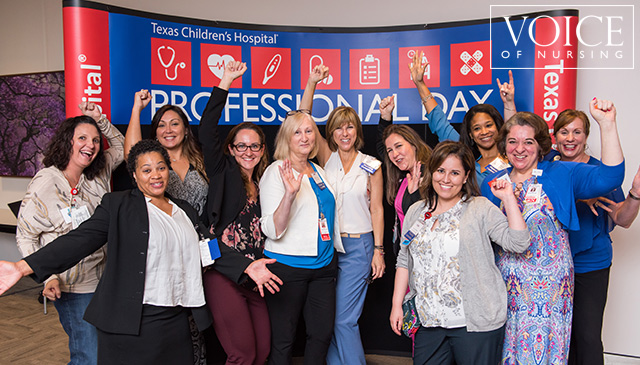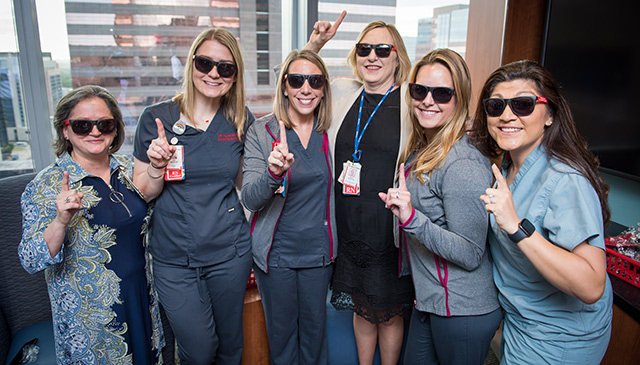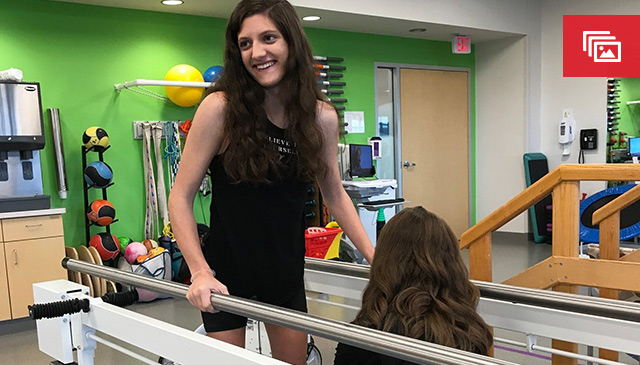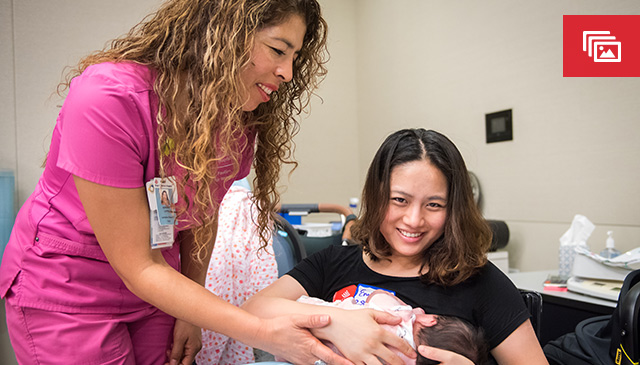
Trang Vu highlights her invaluable experience at Texas Children’s Professional Day and shares why her nursing colleagues should consider attending next month’s conference. Read more

Trang Vu highlights her invaluable experience at Texas Children’s Professional Day and shares why her nursing colleagues should consider attending next month’s conference. Read more

On his blog this week, Mark Wallace shares his excitement about Texas Children’s once again being named among the top children’s hospitals in the nation according to the most recent U.S. News & World Report rankings. He also announces a new Connect series that will feature each of the 10 subspecialty areas ranked in the U.S. News survey and highlight the programs, improvements and advancements that helped earn this year’s outstanding rankings. Read more

Early on the morning of June 18, Texas Children’s Heart Center staff filed into Taussig auditorium on the 16th floor of Lester and Sue Smith Legacy Tower. Details about the meeting’s purpose had been scarce. Little did everyone know that they’d been called in for a big reveal.
Texas Children’s Heart Center had once again been named the best place in the country for pediatric cardiology and heart surgery in the U.S. News and World Report 2019-2020 Best Children’s Hospitals rankings – the center’s third straight year at No. 1.
“It’s thrilling for our team to be recognized for the care we provide to our patients every day,” said Chief of Pediatric Cardiology Dr. Daniel Penny. “Even though we received the top honor, we know there is always room for improvement. We are continuing to evolve as a true multidisciplinary team that is dedicated to setting a new standard for the treatment of children and adults with congenital heart disease.”
The U.S. News rankings use a well-accepted framework for evaluating quality of health care, which factors in patient outcomes, such as mortality and infection rates; available clinical resources, such as specialized clinics and programs and external accreditations; and compliance with best practices. Improved rankings demonstrate a health care organization’s commitment to not only providing high-quality care, but also to identifying gaps where improvements are needed.
But where do you go when you’re No. 1?
“Our goal is to be so far ahead that no one can catch us,” said Dr. Christopher Caldarone, Texas Children’s chief of Congenital Heart Surgery. “Being No. 1 is a state of mind, where commitment to excellence is inherent in everything a program does. Our team has a No. 1 mindset. We work hard, we constantly measure our performance, and we drive ourselves to improve in every aspect of providing care.”
This past year, the Heart Center built on the successes of previously existing programs and also implemented new initiatives to increase transparency, reduce risk of infection and improve the quality of care.
Texas Children’s holds a three-star rating in the STS Congenital Heart Surgery Database (CHSD), which is calculated based on overall risk-adjusted operative mortality for all patients undergoing pediatric and/or congenital heart surgery. The rating is the highest category of quality and places Texas Children’s among the elite congenital heart surgery programs in the U.S. and Canada. Additionally, STS recognized Texas Children’s for having operative and adjusted operative mortality rates that were consistently below expected rates over a 4-year period.
Learn more about the Heart Center, its services, and volume and outcomes.

This past year, Texas Children’s Motion Analysis and Human Performance Laboratory, located at Texas Children’s Hospital The Woodlands, was awarded a prestigious accreditation from the Commission for Motion Laboratory Accreditation (CMLA) – an independent body established to enhance and standardize the clinical care of people with movement disorders.
The lab is now one of only 14 accredited labs in the nation and one of only three in Texas.
“This was an incredible accomplishment for our entire team and a major milestone for the entire Texas Children’s system,” said Dr. Eric Dugan, director of Texas Children’s Motion Analysis and Human Performance program.
Watch a video about the Motion Analysis Lab.
CMLA accreditation is a rigorous, often lengthy process and requires top-to-bottom documentation of everything a motion analysis lab does, how it’s done and the level of quality achieved. This includes evaluation of personnel, administrative structure, clinical and technical data collection methods, quality assurance procedures, and institutional policies. This data is then reviewed by a panel of CMLA experts in orthopedic surgery, physical medicine and rehabilitation, physical therapy, biomechanics, and other related disciplines.
“In early discussions with the CMLA, their estimated timetable for us, from the lab going online to accreditation, was about five years,” said Dugan. “We did it in 18 months, and were one of the fastest ever to receive accreditation.”
Every day, Texas Children’s is getting bigger and better. That’s because our leadership and world-class health care experts are always looking for ways to improve processes, to forge new paths in research, and to ensure an unmatched level of quality care for our patients. And it’s evident in our outcomes and in measures like our recent U.S. News & World Report rankings.
The CMLA accreditation was certainly a factor in the Division of Orthopedics rising five spots to become the No. 10 pediatric program in the country.
“There are so many things that go into the U.S. News rankings, but CMLA accreditation had a positive effect on our position because it helps us ensure we’re offering a full capacity of care for patients with movement disorders,” Dugan said.
The Motion Analysis and Human Performance Laboratory provides the platform for an integrated approach to patient care. The foundational service for the lab is for neuromuscular or clinical gait patients with some form of neuromuscular disorder, such as cerebral palsy or spina bifida. However, lab capabilities are already being expanded to include a comprehensive sports medicine component. Two programs in early phases of implementation are running analysis – to determine any deficits in strength and mobility, or to identify mechanical issues that could lead to chronic injuries – and concussion management, which helps children avoid returning to play too early and experiencing another brain injury and also any possible musculoskeletal injuries that could result from concussion-related changes to postural control.
Clinical gait patients come to the lab as part of pre-surgical or pre-treatment planning to help multidisciplinary care teams determine the best path forward. The evaluation process is intensive and begins with a physical exam with a physical therapist (PT). In this approximately one-hour session, the PT assesses muscle tone, strength, range of motion and other functional measures to get a clear picture of the patient’s condition. A series of 2-D videos and photos are then taken to document standing posture and foot alignment. Patients are then “markered up” head to toe with 70 reflective spheres adhered at specific points on the body. This allows the team in the lab – typically a PT, PT tech and a biomechanist (human motion expert) – to capture a full biomechanical picture of the patient. These experts then work with colleagues in surgery and physical medicine and rehabilitation to analyze the data and develop a treatment plan that fits the needs of each individual patient – patients just like Hannah Deverse.
Hannah was born at 32 weeks, so her parents had been told to expect some developmental delays. However, when Hannah turned one, she still couldn’t sit up or crawl. Her body was stiff and she screamed in discomfort. A neurologist diagnosed her with cerebral palsy.
Over the course of her life, Hannah would need surgeries to alleviate tightness, improve flexion and correct structural deformities. But more than a decade ago, awareness and technology weren’t far along and her parents often felt they were flying in the dark.
“When you have to make difficult decisions about treatment without knowledge, you can feel lost,” said Jessica Deverse, Hannah’s mother. “That was how we felt before we experienced Texas Children’s motion lab. We had two surgeries before the lab was available and two after. We were much more confident with data from the lab. We were presented with multiple options and never felt pressured to do any of them. When we did make a decision, the team answered every single question we had, and we had a clear picture of what the process would be, from beginning to end.”
The data gathered in their initial lab session at Texas Children’s helped experts in pain management determine that Hannah would benefit from a special intrathecal pump to alleviate tightness in her body.
“Have you ever tried to stretch and you just couldn’t reach your toes? It was like that but all over my body for my whole life,” Hannah said. “After I got the pump, I felt like I was walking on clouds. I’d never felt that way before. I asked, ‘Is this how it’s supposed to feel?” because my whole life my body had been so tight.”
Lab analysis also allowed Hannah’s care team to make integral decisions about surgery. Initially it was thought she would need surgery on both knees. But because of the pump helping to control spasticity, the team changed course and decided to operate on only one knee, a surgery performed by Dr. Jeffrey Shilt, chief surgical officer at Texas Children’s Hospital The Woodlands and Texas Children’s chief of Community Surgery, and co-medical director of the Motion Analysis Lab.
“It’s really important that parents know just how much more confident you can feel about making a surgery or treatment decision after seeing and reviewing the data with the team from the motion lab,” Jessica said. “As parents we are often faced with making decisions that will impact the future wellbeing of our children. When you have a child with a disability, the weight of some decisions can be overwhelming because it has drastic lifelong implications. I wish everyone faced with these decisions had this information and this team to work with.”
When Hannah was a baby, her parents were told that she may never walk. Hannah’s proven detractors wrong. Today, she’s 16 years old and has her sights set on getting her driver’s license.
“I’m the only person in my group of friends who doesn’t have a license yet, which is hard on me!” she said. “But I know I’ll get there.”

Shortly after Amber Keckley’s daughter was born, the new mom showed up at Texas Children’s Breastfeeding Friends (BFF) Group to learn more about breastfeeding and to meet other women like herself. For the next several weeks, Keckly learned more than she ever expected about breastfeeding and other issues related to parenting a newborn. She also gained a group of life-long friends.
“After having my first child, I felt very isolated,” Keckly said. “The BFF Group forced me to get dressed, get out of the house and share my feelings with others.”
Keckly liked the group so much, she stayed in touch with some of the moms she met in the group, getting together with them weekly for the first year of her child’s life. She also decided to rejoin the group after her second child was born.
“Mothers can share their experiences openly at the BFF Group, providing them with an additional outlet and a growing, functional compass to help each participant meet their personal goal with breastfeeding,” said Lactation Consultant and BFF Group Leader Brenda Hayden. “Each is invested and confidence just blossoms.”
The BFF Group meets from 10:30 a.m. to 12:30 p.m. every Friday in the patient education room on the fourth floor of the Pavilion for Women. Anywhere from 15 to 30 women attend with their newborns. Facilitated by Hayden, a certified lactation consultant, the curriculum consists of an ongoing six-week series of topics:
“Every week the mix of assembled attendees differs, so even if a mother is repeating a weekly topic, she will have exposure to new insights, tips and information,” Hayden said. “From the moment of introduction, to topics, discussion and open forum, it is our goal that each mother feels heard, validated and supported.”
The BFF Group was created in 2015 as a way to provide additional breastfeeding support to new mothers. Since then, more than 750 women from across the globe have attended. Mothers come from areas far and wide and through other neighboring hospital systems, such as Methodist Hospital, Memorial Hermann Hospital, HCA Houston Healthcare, the Lactation Foundation and the WIC Nutrition Program.
Participants often are accompanied by their mothers, grandmothers, sisters or girlfriends. These additional visitors may participate in the group as well and bring deep generational and regional perspectives, which provide additional support and resources to both new and experienced mothers.
“This program goes along with our overall philosophy at Texas Children’s Pavilion for Women, which is to treat women, mothers and babies with a full continuum of high-quality, expert health care and to do so in a family-centered environment,” said Director of Women’s Support Services Nancy Hurst. “Providing additional breastfeeding support was a natural, intuitive step forward in providing the best in ongoing care for families.”
How do moms learn about the BFF Group?
This is where you continue to have a steady impact! In keeping with the BFF Group’s practice of layering supports, mothers are introduced to multiple resources early on in prenatal classes, during her inpatient stay, during her discharge teaching, and throughout the postpartum period by many OB/CNM and pediatric providers. Many referrals come through word of mouth or by previous BFF Group alumni. In addition, moms such as Keckley return to the group with their second children.
“I tell everyone I can about this group,” Keckley said. “It helped me more than I could have imagined.”
In honor of World Breastfeeding Week August 1-7, Texas Children’s Hospital and the BFF Group are hosting its first Latch-On event where breastfeeding and pumping moms can come enjoy breastfeeding advice, pumping tips, refreshments, a photo booth and prize drawing. The event will be held from 10:30 a.m. to 1 p.m. Friday, August 2 in the patient education room on the fourth floor of the Pavilion for Women. The BFF Group discussion will follow the event. A similar event was held at Texas Children’s Hospital The Woodlands on August 1. Texas Children’s Hospital West Campus will host a breastfeeding awareness event from 11 a.m. to 1 p.m. Friday, August 9.
The BFF Group and other breastfeeding services offered to patients, also are offered to lactating employees. Click here for a comprehensive list of available services.
Texas Children’s Health & Well-Being team has partnered with colleagues from Environmental Health & Safety, Physical Medicine and Rehabilitation and Occupational & Physical Therapy to launch a new video series aimed at preventing an all-too-common occurrence among our employees: the twinges and aches of lower back pain.
The latest offering in our ongoing effort to introduce programs and resources that help keep our workforce healthy and strong, the “We’ve Got Your Back” video series provides expert insight and information to empower you to take care of your back while on the job – no matter your work location, shift or role. Each video in the four-part series features quick, practical tips and advice for avoiding back pain by:
“We know that Texas Children’s has grown exponentially in the last few years and we want to make sure that we provide all of our employees with robust resources to improve their health and well-being,” said Health Coach Jackie Pacheco, who is also a certified personal trainer, ergonomics and safety specialist and athletic trainer.
Ready to start learning how to put back pain on the backburner? Click here to watch Episode 1: Ergonomics with Industrial Hygienist Gary Chang, who shows you how making small changes to your work environment – like adjusting the height of your chair or placing your phone closer within your reach – can make a big impact.
“The goal of the Environmental Health & Safety Department is to identify and correct existing ergonomic injury risks and to proactively identify those jobs that could put employees at risk of a musculoskeletal injury,” Chang said, noting that taking preventative steps can also help reduce the high cost of work-related injuries and mitigate the resulting impacts on our colleagues, our patients and their families.
“Ergonomics interventions allow employees to work safely and reduce the risks of musculoskeletal disorders.”

Anette Sandoval shares a memorable moment she had with her patient who taught her that despite the daily challenges in life, beautiful things often follow life’s toughest storms. Read more